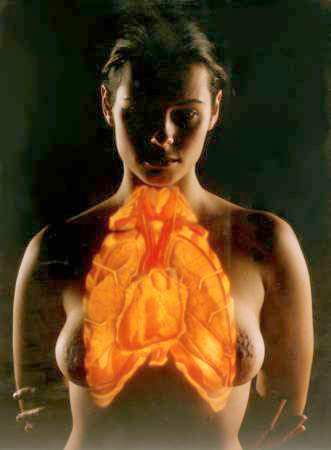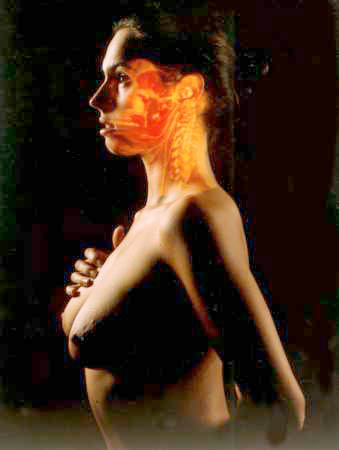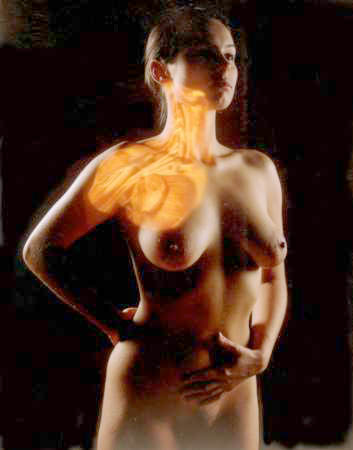Dariusz Gorczyca
CAMERA ANATOMICA
12 IX - 11 X 1997
Krzysztof Jurecki
Dariusz Gorczyca's "Camera Anatomica"
Dariusz Gorczyca belongs to the youngest generation of Polish artists. He is very conscious and skillful as far as the treatment of form is concerned. He is a professional no matter what discipline or artistic technique he happens to be using. The exhibition at the Gallery FF presents his photographic works complemented by a few important objects which broaden his photography and supplement it at the same time, creating a new kind of syncretic work of art.
I. Photographic Paintings
Gorczyca "directs" his photographic portraits which acquire the quality of paintings, because due to their size, colour or diapositives projected onto the body of the model we can speak about the actual staging of his pictures - and staging transgresses the categories of conventional photography. One might add here that Andreas Muller-Pohle in his now classic text "Staging Photography", written in the 1980s, includes the methods used by Gorczyca in his definition of staging. It is of course a form of photography, but at the same time it performs the role of a painting. Such a seemingly breakneck notion was used at the beginning of the 1980s by Cindy Sherman who treated large-format photographs as conscious equivalents of paintings, although from the point of view of the media they are still basically photographs.
The photographs presented at the exhibition have been selected from the water-colour series entitled "Epitaphs", where Gorczyca showed human faces along with "the topography of muscles", hidden under "the envelope of skin" (in the artist's own words).* Taking pictures for his "Camera Anatomica" exhibition Gorczyca worked with Jacek Szpil, a photographer from Cracow, even though the director of the whole project was Gorczyca. It seems that in modern times such form of collaboration has become an accepted and popular method of creation in plastic arts. Postmodernism exposes the role of the bearer of the original idea, the stage director and, consequently, the director, known in advertising agencies as an "art director". This is the function that, for example, Ryszard Horowitz performs, an artist well-known in Poland.
One might stress the significant fact that Gorczyca's model in his daring and sensual compositions was Monika Strzelczyk, a woman he is closely related to. Eight works show her face and various portrait forms in which soft lighting and gestures of arms and legs are important. Naturally the artist evokes the history of portrait photography and even the tradition of classical sculpture, but what we notice most of all are associations with advertising photography, although not exclusively. What is important is the confrontation of the overall "aesthetic" look of the works with the details of the model's skin which after close scrutiny may even appear shocking, for its structure contains something fearful and hideous, something, actually, quite "anti-aesthetic". This specific, conscious artistic perversion is used even more emphatically in other instances. The diapositives I mentioned before, projected onto the model's body, are actually fragments of an anatomical atlas and show the internal organs of the human body. Their graphic representation has been contrasted here with a woman's body. A discordance was created, an unexpected clash that might be shocking to some viewers, since we generally do not imagine what the human body may really look like.
Along the photographs presented on special metal racks the artist also showed a colour xerox copy from an old anatomical atlas, printed in Spanish, which is an allusion to the original idea that became the artist's inspiration. We can only wonder whether the visual form of the pictures should not be more vicious and expressive, like in the case of "Epitaphs". But in such a case Gorczyca would come close to the little-known works by Vistan (Wiesōaw Brzņska) of the 1980s, and even closer to the computer works by Veronika Bromowa of the 1990s which became very popular in Europe. The works of the Czech artist are definitely more vicious and consciously aggressive in their visual form. She overstresses the reddish colours of her realizations and uses close-ups of face details, intentionally reaching the limits of ugliness and horror.
But in the case of Gorczyca his photographic paintings are only a part of an inter-media exhibition. I shall analyze its other significant aspects below.
II. Sound.
A mysterious box. On one of the walls of the Gallery FF the artist installed an old wooden box of an unknown origin, bearing a small note saying "Autopsy record no. 120695". It was a kind of a mysterious found object (l'object trouve) in which a small tape recorder was hidden, playing back a voice which was impassively reading an authentic record of an autopsy. Such a trick, bordering on provocation, possesses a surrealist underlay, as the surrealists stressed the role of the enigmatic magic of a found object which could have always contained death.
And it is death which is important for Gorczyca, which has become a significant phenomenon to be examined from the artistic point of view. While his photographs remind us that death is always present, although hidden, the box in a realistic way points to its physical existence and reveals the artist's ultimate truth.
Heartbeat and breath. The sound was the pre-recorded and transformed heartbeat and breath of Monika Strzelczyk, played simultaneously with the reading of the autopsy record. Many postmodern artists consider the heart - its x-ray picture, or, like in the case of a famous American artist, Bill Viola, its video recording along with the heartbeat of a heart being operated on - a convincing, revealing image for our times. It is one of the most characteristic models and emblems of the end of our era - the age of the downfall of old myths, the historical upheaval after the fall of the Berlin Wall and the times of hope for new cultural patterns.
III. The "Camera Anatomica" object.
Not far from the box, on a revolving tripod, there was an old, time-worn slide projector. It was standing opposite to and not far from an object that might be called an instrument for inflicting and exposing pain. It immediately reminds us of Gorczyca's theatre, where the stage characters are subject to ritualistic, sado-masochistic tortures, inflicted with obvious pleasure. The object resembles mechanical figures of Oskar Schlemer's theatre, developed in the times of Bauhaus. In the case of Gorczyca it is a geometric figure of a human being, mechanical in form and fitted to the body size of Monika Strzelczyk, who becomes a part of an artistic ritual - a kind of performance, in fact, during which Monika is tied to the object. Next, the fragments of the anatomical atlas are projected onto her naked body, the same ones that the artist used in his large format photographs.
In this way Gorczyca unites a theatrical message with photography and performance in front of a live audience. He is also thinking of video recording certain parts of this show.
IV. The Significance of Theory.
I have stressed quite a few times in my essays the essential fact that Gorczyca is one of the most conscious artists of the young generation. It is an important remark because many artists who are popular today will perish in the darkness of history due to the lack of their own, original artistic concept and the fact that they often use various, and sometimes contradicting, attractive cultural artifacts.
Gorczyca's text entitled "Camera Anatomica" confirms this opinion once more. The text underlines the aspect of uniting "the area of death" with the element of "the truth of life". The vitality of life and the image of man have been once again reduced to a key notion in his work - the notion of "a biological machine", fleeting and transitory. The conclusion of Gorczyca's poetic text is the expression of the feeling of "fear" which results from the end of man's biological existence. The concept of "camera anatomica" forms the means of defense against this fear and awe.
V. Summary. Towards a total work?
In spite of the fact that I have described a few separate parts of the exhibition, it is one carefully considered and consistent inter-media whole. Contemporary times demand more and more frequently a total approach on the part of the artist when using new techniques of presentation. Once more in the recent history of contemporary art one hears of "the death of painting" whose idea is revived in other branches of plastic arts, for example with the help of photography. Two big international exhibitions that took place this year confirm the above observation - Documenta in Kassel and Biennale in Venice.
The interest in the anatomy of the human body has a long history, going back to the times of the Renaissance. But the modern explorations acquire new meanings and are conducted in a different context. There are no analyses of the spiritual or the metaphysical spheres, what counts is what is empirical and touchable.
At his exhibition in āņdł Gorczyca examines again some extreme, terminal states, although he does not cross the final border like other postmodernists, for example Damian Hirst, a British artist, or Zbigniew Libera, a Pole, who believe that artistic acts should cause shock. Modern artists employ such extreme means of expression because they are losing contact with their public and with the art market, whose role in today's world is enormous. Meanwhile the neoavant-garde has locked itself in artistic ghettoes, so it is small wonder that some artists believe in the necessity of shock therapy.
The inter-media exhibitions by Gorczyca, originating from the tradition of the plastic theatre, from time to time annex new territories and new techniques of presentation. Perhaps he is not far from creating a theory of a total work. But he will also have to define his position and creative methods related with the problem of affecting the receiver - is art possible today without indignation and the transgression of generally accepted ethical norms?
Conclusion.
Theodor W. Adorno, considering Walter Benjamin's theory devoted to the disappearance of the aura of a work of art, formulated his own concept of the notion of "apparition" - as used to describe, for example, a momentary flash of fireworks in the sky. According to Benjamin, art devoid of its aura is based on the notion of a short-lived shock, but, according to Adorno, as Karol Sauerland correctly pointed out, "it is prepared to destroy its own charm without giving up its mysteriousness and its bewitching magic of destruction".** Analyzing the aesthetics of the German art theoretician, Sauerland said: "On the other hand, according to Adorno, a chance to last, or at least to last for some time, have only those works which try to grasp and transcend what is fleeting and momentary. "If <an apparition> means a flash, a fleeting touch, then its image is a paradoxical attempt to grasp something that is extremely short-lived. In works of art the transcendence of transitoriness is achieved.""***
Many phenomena of 20th century art may be seen from the point of view of the above mentioned philosophers of art, who correctly diagnosed its changeable nature and layed the foundations of new aesthetics since old categories had in time lost their validity. A great many phenomena of most recent art resemble a momentary flash of fireworks in the sky. But only those will be universally remembered which consider the problem of transcendence, the problem that has been related for ages with human existence and our fear of death.
Krzysztof Jurecki
Notes:
* See D. Gorczyca, "Portret", in: Dariusz Gorczyca, "Epitafia", Artemis Art Gallery, Cracow 1996 (a catalogue of the exhibition).
** I quote Adorno's views after K. Sauerland, "Od Diltheya do Adorna. Studia z estetyki niemieckiej", Warsaw 1986, pp. 202 and 203.
*** K. Sauerland, ibidem, p. 202.
Copyright ©1997 Galeria FF £DK, Krzysztof Jurecki



